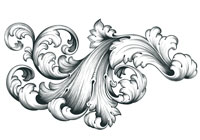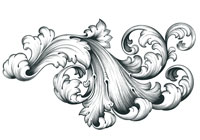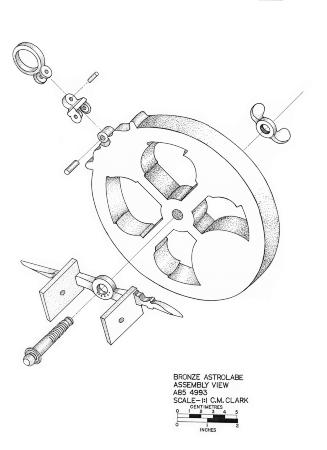 Explainer: The Mariner’s Astrolabe
Explainer: The Mariner’s Astrolabe
The principal device for determining latitude in 1622 was the mariner’s astrolabe—a heavy, wheel-like, brass implement. The astrolabe was engraved with scales running from 0-90° and a pivoting pointer (alidade) fixed with two protruding, parallel plates; each plate pierced by precisely-aligned pinholes (pinnules) that allow the sun’s rays to pass through.
In his ship-handling treatise of 1587, Instrucción Náutica, Dr. Diego Garcia de Palacio provides a detailed description for the proper use of the mariner’s astrolabe. According to his instruction, observations of the sun had to be made exactly at noon while standing near the mainmast of the ship, where there was the least amount of pitch and roll. The astrolabe was held side-on to the sun and the alidade rotated until the sun’s rays passed through both pinnules and shined as a spot of light on the deck or ground. The number on the scale indicated by the alidade pointer was the measure of the angle of the sun’s altitude above the horizon.
One other figure was needed to properly establish the observer’s latitude—the angle of the declination of the sun. Declination is the angle between the sun’s rays and the earth’s equatorial plane, and it ranges between 23.5° at the summer solstice and –23.5° at the winter solstice. By the sixteenth century, tables had been calculated for the declination of the sun to the north or south of the equator for a given date, and for whether it was a leap year or the first, second, or third year after it. To determine the latitude at which the measurement was taken, the difference between the astrolabe reading and 90° was first calculated. The result was then added to the declination figure from the tables. This is can be expressed as: (Zenith – Altitude) + Declination = Latitude.
Theoretically, determining latitude with an astrolabe is a simple process, but it was likely not so easy in practice. The precision with which the astrolabe was crafted is the primary determining factor for accuracy. To yield precise and consistent readings, the astrolabe had to be meticulously crafted: the alidade had to fit snugly against the wheel, the pinnules had to be drilled in perfect alignment, the pointers straight, and the scale had to be cut exactingly. Errors would be compounded by taking readings on a moving ship.
Hands-on experimentation has shown that it is much easier to obtain readings by holding the astrolabe low and observing the point of light that passes through the pinnules as it strikes the deck (or ground). Suspending an astrolabe above one’s head and trying to align the alidade to sight the sun with the eye is blinding and does not produce accurate readings.
With accuracy being so dependent upon the construction and condition of an astrolabe, it might be clearer why the Nuestra Señora de Atocha’s pilots, Martin Jimenez and Francisco de Cardenas Garay, felt the need to carry at least five of them. Perhaps each astrolabe had specific characteristics for varying sea, weather, or astronomic conditions. It also seems likely that it was for sheer redundancy. Slight wear, or other mechanical damage, could render an astrolabe inaccurate, but not overtly so. Redundant recordings of the sun’s altitude with more than one astrolabe would yield greater confidence in the final measure, and thus the course on which the ship was sailing.
In his ship-handling treatise of 1587, Instrucción Náutica, Dr. Diego Garcia de Palacio provides a detailed description for the proper use of the mariner’s astrolabe. According to his instruction, observations of the sun had to be made exactly at noon while standing near the mainmast of the ship, where there was the least amount of pitch and roll. The astrolabe was held side-on to the sun and the alidade rotated until the sun’s rays passed through both pinnules and shined as a spot of light on the deck or ground. The number on the scale indicated by the alidade pointer was the measure of the angle of the sun’s altitude above the horizon.
One other figure was needed to properly establish the observer’s latitude—the angle of the declination of the sun. Declination is the angle between the sun’s rays and the earth’s equatorial plane, and it ranges between 23.5° at the summer solstice and –23.5° at the winter solstice. By the sixteenth century, tables had been calculated for the declination of the sun to the north or south of the equator for a given date, and for whether it was a leap year or the first, second, or third year after it. To determine the latitude at which the measurement was taken, the difference between the astrolabe reading and 90° was first calculated. The result was then added to the declination figure from the tables. This is can be expressed as: (Zenith – Altitude) + Declination = Latitude.
Theoretically, determining latitude with an astrolabe is a simple process, but it was likely not so easy in practice. The precision with which the astrolabe was crafted is the primary determining factor for accuracy. To yield precise and consistent readings, the astrolabe had to be meticulously crafted: the alidade had to fit snugly against the wheel, the pinnules had to be drilled in perfect alignment, the pointers straight, and the scale had to be cut exactingly. Errors would be compounded by taking readings on a moving ship.
Hands-on experimentation has shown that it is much easier to obtain readings by holding the astrolabe low and observing the point of light that passes through the pinnules as it strikes the deck (or ground). Suspending an astrolabe above one’s head and trying to align the alidade to sight the sun with the eye is blinding and does not produce accurate readings.
With accuracy being so dependent upon the construction and condition of an astrolabe, it might be clearer why the Nuestra Señora de Atocha’s pilots, Martin Jimenez and Francisco de Cardenas Garay, felt the need to carry at least five of them. Perhaps each astrolabe had specific characteristics for varying sea, weather, or astronomic conditions. It also seems likely that it was for sheer redundancy. Slight wear, or other mechanical damage, could render an astrolabe inaccurate, but not overtly so. Redundant recordings of the sun’s altitude with more than one astrolabe would yield greater confidence in the final measure, and thus the course on which the ship was sailing.
